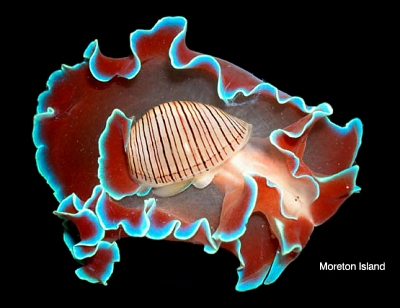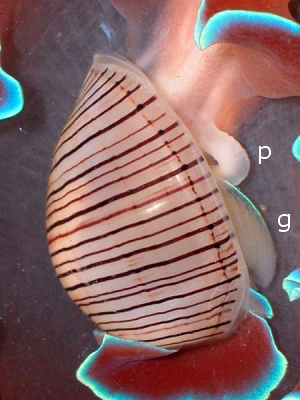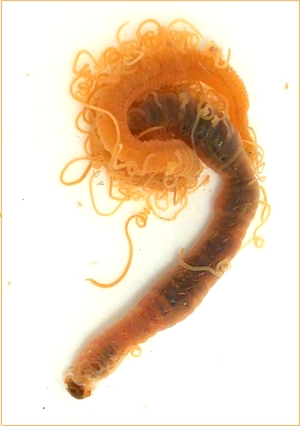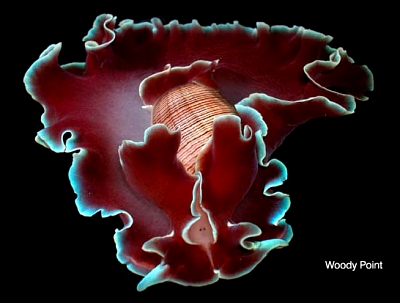Hydatina physis from sthn Queensland
January 21, 2009
From: Gary Cobb

Concerning message #16645:
Hi Bill and Everyone!
Here is another record from our backyard. This is Hydatina physis which has been found subtidally and intertidally here. I have also taken taxonomic photos of the shell, showing the gills. Also it's food source, the polychaete worm, Cirratulidae, Timarete sp.
On dives the animal is found at night. Intertidally it occurs during the day time hours!
Locality: Sunshine Coast, sthn Queensland, 15 m - intertidal, Queensland, Australia, Pacific Ocean, 08 August 2008, Subtidal and Intertidal. Length: max 60 mm. Photographer: Gary Cobb.
Cheers
Gary
gary@nudibranch.com.au



Dear Gary,
Thanks for these nice photos. In your photo of the shell we can see not only the gill [which I have marked g] but also the penis [p]. Hydatina is one of the few opisthobranchs which retains an external penis like this, almost all the others have an eversible penis which is usually hidden in an internal sac when not in use. In cephalaspideans this sac is usually on the right side of the head. Interestingly, many marine snails have an external penis situated in much the same position as Hydatina.
Thanks also for the photo of its food worm. Have you actually seen it feeding? Why I ask is that when I first discovered the food of this species I was relying on stomach contents. Because of the extremely elongated oral tube I suggested that it must capture its prey by everting this long 'proboscis' down the burrow of the worm, or the crevices in which it lives. Valda Fraser's photos [#21498] showing an everted black tube certainly supported this hypothesis, but I have never witnessed Hydatina actually feeding, so I would be interested in an 'eyewitness' account if you have seen it in action.
-
Rudman, W.B., 1972. The anatomy of the opisthobranch genus Hydatina and the functioning of the mantle cavity and alimentary canal. Zoological Journal of the Linnean Society, 51: 121-139.
Best wishes,
Bill Rudman
Related messages
-
Re: Food for the bubble shell Hydatina physis?
From: Lindsay Lyles, December 16, 2009 -
Hydatina physis from Florida
From: Linda Ianniello, July 7, 2008 -
Amazing proboscis on Hydatina physis from Sth Africa
From: Valda Fraser, April 8, 2008 -
Hydatina physis from Gold Coast, Queensland
From: Ian Banks, May 20, 2006 -
Hydatina physis mating
From: Marina Poddubetskaia, July 2, 2005 -
Hydatina physis laying eggs
From: Marina Poddubetskaia, July 2, 2005 -
Mysterious pink nudibranch from New South Wales
From: Eliza Middleton, January 27, 2005 -
Hydatina physis laying eggs
From: Ian Hutton, January 28, 2004 -
Hydatina physis from Japan
From: Yukari Sato, December 20, 2003 -
Re: A rose of a different color
From: Paul Whitehead, October 6, 2003 -
Hydatina physis from Japan
From: Kayoko Eto, June 11, 2003 -
Pair of Hydatina physis
From: Leanne & David Atkinson, June 7, 2003 -
Hydatina physis from Senegal
From: Marina & Patrice , April 19, 2003 -
Hydatina physis from Lord Howe Island
From: W.B. Rudman, January 24, 2003 -
Hydatina physis - more photos
From: George Evatt, June 2, 2001 -
Hydatina physis in Sydney
From: George Evatt, June 1, 2001 -
A rose of a different color
From: Mary Jane Adams, June 6, 2000 -
Hydatina, again
From: Peter Wirtz, February 15, 2000 -
Hydatina stromfelti v Hydatina physis
From: Marco Neiber, February 2, 2000 -
Food for the bubble shell Hydatina physis?
From: Ian Smith, December 19, 1999 -
What is the 'Rose Petal Bubble Shell'?
From: Lauren Peck, August 23, 1999
